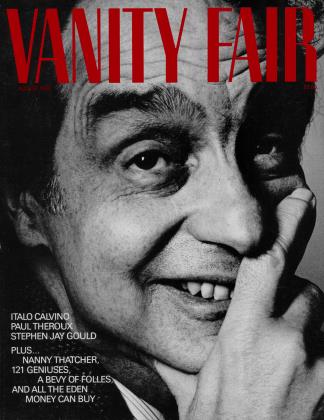Sign In to Your Account
Subscribers have complete access to the archive.
Sign In Not a Subscriber?Join NowISTANBUL
Brian Sewell
"You must hobnob with ghosts, for Atatürk dispensed with Society"
After the dead dogs that litter the roads of Greece, the frightful food of Macedonia, the hostility of the rural peasant, and the shrewd exploitation of the Aegean sophisticate, the Turkish border is the gate of paradise. Mud-wallowing buffalo and strings of camels on the Thracian skyline suggest the crossing not of a border but of a time warp, and the creaking charms of the Pera Palace in Istanbul confirm it.
The ancient city of Constantinople, the alternative Rome of the Dark Ages, is perched on a great promontory at the entrance to the Bosporus; as Byzantium it was the fulcrum of a Christian empire that stretched from Sardinia to the Caucasus; as Istanbul it was the Sublime Porte to an empire that embraced Casablanca and the Persian Gulf and reached the walls of Vienna. History erupts through its crust, and the very air, even in the heat of summer, seems still to be cooled by the turbulent battle fought between the sons of the north wind and the goddesses of the sudden storm as the Argonauts made their way against the swift current to the Black Sea and the Golden Fleece. If you must cling to fact, then it is this current, flowing toward the Sea of Marmara and on to the Aegean, that brings the breezes to cool the stews of the busiest city in Europe.
It is busier than ever this summer, and until the end of October it is host to "The Anatolian Civilizations," a formidable exhibition of the art and artifacts of every civilization that has ever had a foothold in Asia Minor. The Greeks and Romans are there, of course, with their baroque Hellenistic splendors and their imperial classicism, reversing our Renaissance; the Byzantines demonstrate the appalling decline that sets in when sex is removed from art and small superhuman gods are replaced by a great mystery without sensuality; the Seljuk Turks brought Islam and the arts of Persia with them, and the Ottoman Turks raised sybaritic richness to fine art before lowering it to Bavarian vulgarity. The Hittites, among whom dwelt the Children of Israel and who sold land to Abraham, are there, and so is the ghost of that mephitic old puritan St. Paul, who, by taking sex out of religion, reduced art to Byzantine ciphers.
For anyone to whom these broad historical concerns are of interest, this exhibition is a brilliant reward; for butterflies to whom jewelry older than Helen and the wooden horse of Troy, or the accoutrements of circumcision, may give pleasure, the show will add a dash of erudition.
Only hard work will get the visitor round all the sites devoted to this enormous exhibition—the newly refurbished Church of St. Irene, the palace of Suleiman the Magnificent's Grand Vizier, the House of the Whirling Dervishes, the Military Museum, and Topkapi, which with nothing in it would still be the most beautiful museum in the world.
Take time off for the tourist trip up the Bosporus, by boat if possible, past timber villas that recall both Venice and Cathay, past ancient forts and new fleets. On the European side the newly restored Malta Pavilion and the bosks and gardens of Yildiz Park convey some idea of Ottoman imperial splendors on a domestic scale, and on the other there is Kiicuksu—the Sweet Waters of Asia—where the Ottoman court so elegantly camped in its heyday. You must hobnob with ghosts, for Atatiirk dispensed with Society.
Affluence has brought a Hilton to the city, with an excellent restaurant—but in a decade I've not had a bad meal anywhere, whether among the workers in the spice market or the wealthy shoppers lunching in the Pandeli. Turkish food is the best in the Levant, with its meze—a sequence of delicious hors d'oeuvres that satisfies most European appetites—infinite variations on the kebab, and fine fresh fish. The Palet 2, up the Bosporus at Tarabya, is perhaps the best of fish restaurants, amid the hustle of the waterfront and the gilded youth of Istanbul, but the flash photographers there are tiresome. The belly dancers may well have been imported from Chicago—no modest adherent of the faith of Islam would dream of transferring water from a full to an empty glass with one flip of her flab except in the privacy of her home.
These pleasures and delights will always be there, but the exhibition will not. The city's name is a corruption of the Greek words is tinpolin— to the city. Take them as an admonition and go to Istanbul before October ends.
 View Full Issue
View Full Issue






Subscribers have complete access to the archive.
Sign In Not a Subscriber?Join Now